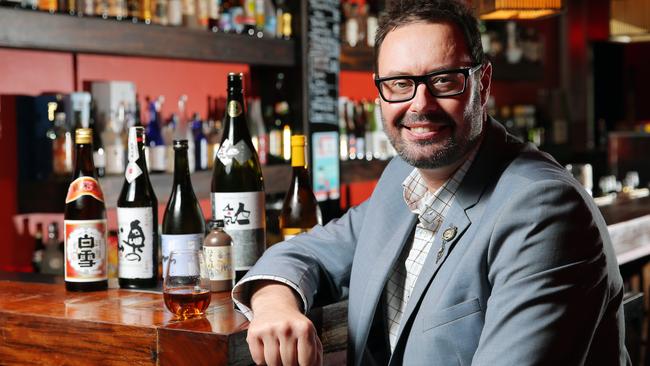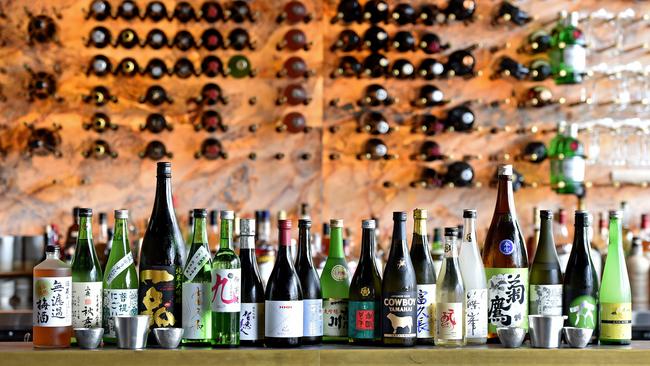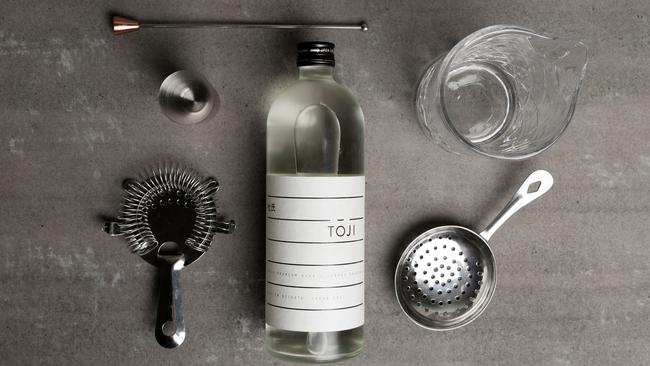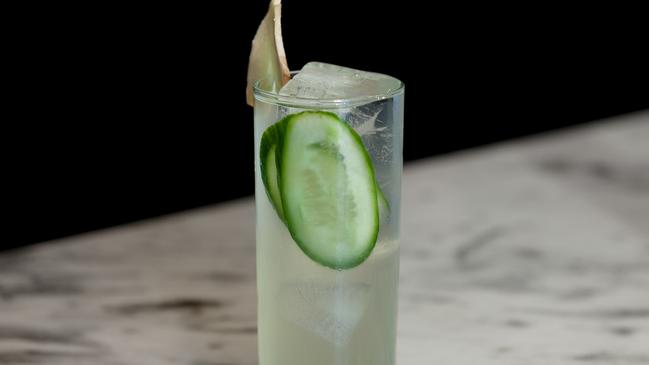Japan’s national drink, Sake continues to grow in popularity in Australia
Sake is cruising up the favourite-drink food chain and is now beloved by barmen and top sommeliers, being paired with a range of foods on high-end menus, and used as a versatile ingredient in light, bright cocktails. Here’s why.

Eating Out
Don't miss out on the headlines from Eating Out. Followed categories will be added to My News.
It began as a childhood love of anime, developed into a teenage obsession with Japanese gadgets and design and ended up becoming the coolest job title in the world.
Andre Bishop is a Sake Samurai.
The Melbourne bar owner, educator and sake distributor was bestowed the honorary title by the Japanese Sake Brewers Association for his dedication to spreading the good word of Japan’s national drink in Australia.
That lifelong love of all things Japanese led, naturally enough, to travels throughout the country where Bishop was exposed to local craft sake which was a world away, literally, from the mass-market, low-quality sake served in Australia in the mid 1990s.
“I wanted to share what I’d discovered with Aussies, this amazing beverage that goes so well with food,” Bishop says.
“At the time, sake was the domain of Japanese restaurants, served piping hot from a microwave. That’s all Aussies knew.”
Bishop opened Australia’s first bar dedicated to Japanese sake, Robot in Melbourne’s CBD, in 2000 with Izakaya Chuji and sake bar Nihonshu to follow in the city, as well as Kumo Izakaya in Brunswick East.
Today, sake is beloved by barmen and top sommeliers, being paired with a range of foods on high-end menus and being used as a versatile ingredient in light, bright cocktails.
“It’s been an enjoyable experience watching the growth, acceptance and appreciation of sake over the years, which really ramped up six, seven years ago,” Bishop says.
“The experience of being served a piping hot sake, and waking up with a terrible hangover in the morning, that’s much rarer now.”

WHAT IS SAKE?
What in the west is commonly called sake is known in Japan as nihonshu — “Japanese liquor” — and is made from four ingredients: rice, water, koji and yeast. Like beer sake is brewed, unlike a spirit, which is distilled.
“I believe some people perceive sake like a harsh spirit like a vodka or tequila. I feel sake is more like a delicate white wine,” says Yuta Kobayashi from Toji Sake.
Taking its name from the Japanese term for sake brewmasters, Toji is created in Japan for the Melbourne-based company and is served in restaurants including Eazy Peasy Japanese yakitori in Richmond, which Kobayashi runs with wife Shar.
HOW IS IT MADE?
The magic of sake, says Bishop, is that the rice has to be inoculated with a special mould called koji (aspergillus oryzae) before it will undergo fermentation. The mould saccharifies the rice — turns its starch into sugar — which yeast feeds onand converts into alcohol.
“Unlike wine or beer where sugars are naturally present (in the base ingredients), there is no sugar in rice, so it has toundergo this miracle of propagation of koji mould onto the rice. That’s a very special part of the sake brewing process,” Bishop says.
That inoculated rice is steamed, blended with other steamed rice, mixed with water and yeast and allowed to ferment.
NAIL THE POLISH
Before the rice is inoculated, however, it first undergoes a process known as milling or polishing. Rice grains have a hardlayer of fats and proteins that surround the pockets of starch in the centre that are needed for fermentation. Milling takes away these outer layers, and sake is graded according to how much of the rice grain has been milled away. A sake with a 70 per cent rating is made from rice with 30 per cent milled away; a sake with a 50 per cent rating is made from rice milledto half its original size.
“In general, the more the outer is milled away, the more delicate and refined the sake will be,” Bishop says. “It doesn’tnecessarily mean highly milled is better, but it definitely affects the cost. If you’re milling away 50 per cent of the riceyou’ll need 50 per cent more rice.”

ADDED ALCOHOL
Sake is also categorised into junmai and non-junmai.
Junmai — which means “pure rice” — has no brewer’s alcohol added, whereas non-junmai has some alcohol added after the fermentationprocess.
Non-junmai was how sake was made during WWII — brewers were ordered by law to bolster their yield with alcohol to preserverice stocks — and the method persisted through the 1950s and ’60s.
“Then brewers started going back to the old ways where the alcohol is derived solely from the fermentation of rice,” Bishopsays.
Today, non-junmai sake contains very small amounts of brewer’s alcohol, which is usually added to lift an aromatic or bolsterflavour. “It’s used in a delicate, thought-out way,” Bishop says.
“In Japan, the junmai category is popular, as it’s seen as the purest form.”
THE MATRIX
Therefore, sake comes in six categories based on both the milling rate and whether any alcohol has been added.
The minimum milling percentage to be considered true sake is 70 per cent and is known as junmai (pure) or honjozo (alcoholadded). Junmai ginjo/ginjo has a polishing ratio of 60 per cent, while premium sake with a polishing ratio of 50 per cent or less is known as junmai daiginjo/daiginjo.
“Even if the bottle is all in Japanese, you’ll see two percentages, one will be the alcohol, the other will be the millingrate,” Bishop says.
GRADE SCHOOL
High grade sakes, Bishop says, are usually more delicate with floral, fruity aromatics, while lower grades might be more savourywith rice and yeast characteristics.
“You might want something more savoury and full-bodied, especially when pairing with food,” Bishop says.
The aromas and flavours found in each sake depends on the type of sake, where it’s produced, the water, the rice and the brewer, Kobayashi says.
“For example Toji Junmai Daiginjo has a melon aroma and is light, fresh and crisp (which are) characteristics of the regionit is produced, Niigata, Japan. While Toji Junmai Ginjo has apple aromas and again has the characteristics of a Niigata sake,” he says.

YOU’RE HOT THEN YOU’RE COLD
“Sake has changed over the years, the whole tradition of warming sake goes to earlier times, when it was rougher and hadn’tevolved into the quality of today,” Bishop says. “Cheap and nasty sake was enjoyed warm as it made it easier to drink. It was also a tradition in Japan to heat sake to drink it in winter as it warmed you up.”
Today, the more highly milled, delicate styles are designed to be drunk cool, like a white wine. But the heavier, robust, savoury styles can be “very enjoyable warm”.
“But the golden rule is don’t overheat sake. A microwave is a no no.”
ARE YOU BEING SERVED
The best way to capture and enjoy the delicate aromatics of a daiginjo sake is to drink it from a wine glass.
“The brewers have often gone to great lengths to make the highly aromatic styles. Serving it in a wine glass, and being ableto aerate it as you would a wine, is the perfect way to enjoy it,” Bishop says.
Alternatively, you can opt for a traditional sake which includes a tokkuri — a serving carafe — and the small cup known as the ochoko.
“At Eazy Peazy (we serve) sake straight in glass flutes from Italy or even as a cocktail,” Kobayashi says.
WINE NOT
Bishop says sake can be as textural and complex and nuanced as wine, and to prove it is holding a sellout sake versus wineevent at this year’s Melbourne Food and Wine Festival in March.
“We held this event six years ago and sake won,” Bishop says.

SAKE MOSCOW MULE
Ingredients
● 60ml Tōji sake
● 15ml lemon juice
● Some ginger, cubed
● Cucumber slices
● Ginger beer
● Ice
Method
Muddle ginger and add Tōji sake, lemon juice, and cucumber slices.
Add ice and stir until the
ingredients are slightly diluted.
Top with ginger beer.
Garnish with slice of ginger.
READ MORE:
RESTAURANT THAT MAKES DRINKING WINE FUN AGAIN
WHERE TO TRY ONE OF THE BEST DISHES OF THE YEAR
CROWN LASHES OUT AT ‘FANCIFUL’ HESTON CLAIMS
OTHER MFWF JAPANESE-THEMED EVENTS
FOOD AND FAMILY: THE JAPANESE WAY
Enjoy a traditional asagohan Japanese breakfast of tamago-yaki (omelette), grilled fish, miso soup, pickled vegetables, rice and green tea at Collingwood cafe CIBI on March21 and 28.
SUMO LIBRE
Japan meets Mexico for three rounds of creative freestyle food and drinks at new Carlton hotspot, Taquito on March 19 and 26.
WASABI NOOSA X SAN TELMO
Zeb Gilbert from acclaimed Noosa restaurant Wasabi will join chef Stephen Clark on the San Telmo grill for a night of inspiredwood-fired Japanese seafood on March 28.
CONVENIENTLY TOKYO
Enjoy Japanese convenience store classics — egg salad sando; onigiri; karaage — at Windsor’s Tokyo Tina on March 25 and 26.
YAKITORI WITH SHER WAGYU
Smoky skewers of world-class beef cooked over binchotan charcoal sounds like a mighty fine way to spend an evening at SteerDining Room on March 26.
FOR FULL PROGRAM AND TICKETS: MFWF.COM.AU

